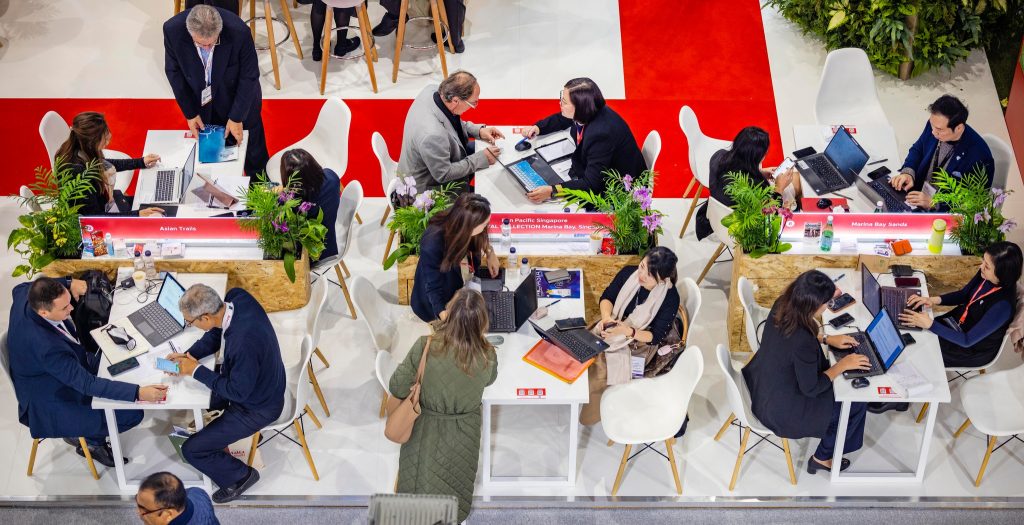Food control during a reception

Share news
Listen
Receptions give attendees a chance to mix and mingle with more people, offer a wider variety of foods, and can be designed to fit virtually any budget.
Why a reception?
A reception is usually less formal than a sit-down dinner, although it can also have a gala theme or fit a high-class event. It is suitable for product presentations, or as a welcoming event for a convention or a congress, especially during the first night. When people are flying in from a distance, it’s a good idea to offer them something substantial to eat rather than leaving them on their own for dinner. They could jam up the hotel’s restaurants or not get the times they’re looking for. And trying to get out on the town usually isn’t convenient on the opening night.
The reception has plenty of advantages.
– First, it provides an informal, flexible evening, facilitating networking opportunities for the guests present. If people can interact freely on the first night, rather than be stuck with the same 9 people during 2 hours at a table, no doubt your guests will be much more at ease. Provide of name tags if people donÂ’t generally know each other: they facilitate contact a lot. It also allows attendees to dress casually and have a more relaxing evening than sitting down at a table.
– It also works better than a sit-down dinner because it accommodates people arriving at different times (great when guests come by different planes – you just know some of them will arrive late!).
– It also gives the meeting planner an opportunity to welcome them, orient them, give them whatever materials they need, and answer their questions before business kicks off the next morning.
– Receptions are also cheaper than a sit-down dinner. The food stations can offer variety while including some economical food.
– It can also be easy to decorate the reception area according to a theme or simply with some simple decoration such as large leaves on top of which the food can be placed, or vases of various colours with floral decoration on each food station.
– You can also incorporate an interactive element: live music, dancers, activities can be brought in apart from catering a menu to a specific theme. It is simple and it promotes interaction among the attendees.
Points to note
Regardless of whether you’re planning an elaborate reception or an hour-long function, here are some precautions to prevent skyrocketing costs and traffic flow problems. Please note that these tips are designed to lower your costs. Apply them wisely, taking into account the type of reception, the type of public and the level of “luxury” you want to offerÂ…
– Know your audience. The more accustomed people are to receptions and hors d’oeuvres, the fewer they’ll consume. Bankers, doctors, and businessmen, for example, tend to under-consume hors d’oeuvres. Because of their businesses and lifestyles, they’re exposed to those functions often and are less fascinated by the different food offerings. So you can order less food and still have plenty left over. Conversely, for a general public or families or who are on restricted budgets, careful planning is essential. People in these groups will find new ways to fit 25 hors d’oeuvres on one plate. Without proper guarantees, setup, and controls, the most generous hors d’oeuvre spread is likely to be gone in no time.
– Get waiters to serve the hors d’oeuvres. Your labour charge will be higher, but that should be offset by a lower food cost since people consume less when foods are passed (if they go to the food station, they will “fill up” their plate). Generally, if foods are displayed on a buffet table so that guests can help themselves, they’ll eat twice as much as they would if all the foods were passed on a tray by a waiter. You also can control the pace of service. For instance, you can stagger service by sending out waiters with trays every 15 minutes instead of taking all the food out at one time.
– When serving passed foods, place only one type of food on each tray. Otherwise, attendees will take too long to make up their minds and they may take one of each. This will slow down service because the waiters won’t be able to work the room quickly and efficiently.
– Position buffet tables against a wall. Consumption drops when delegates don’t have 360-degree access to the tables.
– Don’t use dinner-sized plates. Doing so encourages overeating as well as waste. A guest may fill a plate, eat some of the food, set the plate down somewhere, forget it, and then go back for another plate of food. Furthermore, people with large plates of food will tend to sit down to eat and will not mingle and network very much, if at all. Use salad or bread and butter plates instead. Or, when feasible, simply provide napkins.
– Station a server at each buffet table. His or her function should be to replenish foods, clear soiled tableware, remove trash, and act as a "psychological deterrent" to curb attendees’ tendencies to overload their plates or return several times.
– Offer larger quantities of fewer kinds of hors d’oeuvres. If you have six types of hot hors d’oeuvres, people may take two of each for a total of 12 per person. But if you have four types and people take two each, they’re only consuming eight per person.
– Provide starchy and high-protein foods. Such foods stay in the bloodstream longer and delay the absorption of alcohol into the body. Avoid salty, greasy, or sweet foods, which create a thirst that guests will inevitably quench with additional drinks.
– Ensure that hors d’oeuvres are bite-sized. This will make the food easier to eat and will allow attendees to sample a variety of foods without much waste. They also should be easy to hold and eat — not messy or greasy. Avoid sauced foods, such as barbecued chicken wings, which might drip when guests are eating them. Instead, offer chicken tenders with a stiff sauce served on the side.
– Keep seating to a minimum. The availability of tables and chairs encourages people to sit and eat rather than network. Chairs for 25 percent to 30 percent of attendees is optimal.
– Remember that distractions such as music, entertainment, and dancing reduce food consumption.
Guidelines for the beverage part of the function include the following:
– Set up one bar for every 75 guests. After the sixth bar, you may be able to scale back to one per 100.
– Spread out the bars to encourage people to move around the room and help keep lines manageable. You don’t want the bars close to food stations or seating areas. They need to be in reasonable proximity.
– Don’t open all the bars at once. Open the bars farthest from the entrance first in order to avoid bottlenecking. Open the bars closest to the entrance last.
– Don’t close all the bars at once. Close the bars at the rear of the room first –15 to 20 minutes before the end of the reception. Then, after eight or nine minutes, begin working your way to the front of the room.










